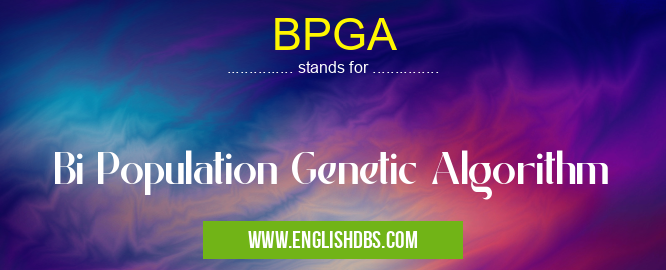What does BPGA mean in HUMAN GENOME
Bi Population Genetic Algorithm (BPGA) is a powerful optimization technique inspired by the principles of genetics and natural selection. It is a variant of the Genetic Algorithm (GA) that utilizes two populations instead of one, allowing for enhanced exploration and exploitation of the search space.

BPGA meaning in Human Genome in Medical
BPGA mostly used in an acronym Human Genome in Category Medical that means Bi Population Genetic Algorithm
Shorthand: BPGA,
Full Form: Bi Population Genetic Algorithm
For more information of "Bi Population Genetic Algorithm", see the section below.
» Medical » Human Genome
Working Principle
BPGA initializes two populations, typically of equal size. These populations evolve independently, undergoing genetic operations such as selection, crossover, and mutation. The key distinction lies in the exchange of individuals between the populations, which occurs at regular intervals.
Exchange Mechanism
The exchange mechanism in BPGA is designed to facilitate the sharing of beneficial genetic material between the populations. It involves selecting a subset of individuals from each population and exchanging them with their counterparts in the other population. This cross-pollination allows for the introduction of new genetic diversity and the avoidance of premature convergence.
Benefits of BPGA
- Enhanced Exploration: The use of two populations provides a larger and more diverse search space, increasing the likelihood of finding optimal solutions.
- Improved Exploitation: The exchange mechanism facilitates the transfer of promising genetic material between populations, allowing for faster convergence towards better solutions.
- Population Diversity: BPGA maintains two distinct populations, which helps prevent premature convergence and ensures a broad exploration of the search space.
Applications
BPGA has been successfully applied in various optimization problems, including:
- Numerical function optimization
- Combinatorial optimization
- Scheduling and resource allocation
- Machine learning and data mining
Essential Questions and Answers on Bi Population Genetic Algorithm in "MEDICAL»GENOME"
What is BPGA (Bi Population Genetic Algorithm)?
BPGA is a genetic algorithm that utilizes two populations, each with its own set of chromosomes. One population represents the current solution, while the other population represents the potential solution. The algorithm iteratively evolves both populations, allowing for the exchange of information and the exploration of a wider search space.
How does BPGA work?
BPGA starts with initializing two populations randomly. Then, it iterates through the following steps:
- Selection: Individuals with higher fitness values are selected from both populations.
- Crossover: Selected individuals undergo crossover to exchange genetic material and create new offspring.
- Mutation: Offspring are subjected to mutation to introduce genetic diversity.
- Evaluation: The fitness of the offspring is evaluated.
- Migration: High-performing individuals from one population are migrated to the other population.
- Replacement: The weakest individuals in each population are replaced with the offspring.
What are the advantages of using BPGA?
BPGA offers several advantages:
- Improved exploration: The dual population structure allows for a wider search space exploration.
- Enhanced exploitation: The exchange of information between populations facilitates the exploitation of promising solutions.
- Increased population diversity: The migration mechanism helps maintain population diversity and prevents premature convergence.
Where is BPGA commonly applied?
BPGA is widely used in various optimization problems, including:
- Scheduling problems
- Image processing
- Machine learning
- Bioinformatics
- Finance
Final Words: BPGA is a robust optimization algorithm that leverages the principles of natural selection and population diversity to find optimal solutions to complex problems. Its enhanced exploration and exploitation capabilities make it a valuable tool for researchers and practitioners in various fields.
